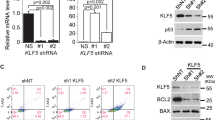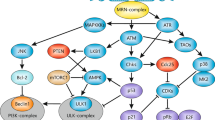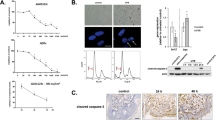Abstract
GENOTOXIC stress triggers signalling pathways that mediate either the protection or killing of affected cells. Whereas induction of p53 involves events in the cell nucleus1, the activation of transcription factors AP-1 and NF-κB by ultraviolet radiation is mediated through membrane-associated signalling proteins, ruling out a nuclear signal2–6. An early event in AP-1 induction by ultraviolet radiation is activation of Jun kinases (JNKs) 3,7, which mediate the induction of the immediate-early genes c-jun and c-fos7–13. The JNKs have also been proposed to mediate the apoptopic response to genotoxins14. The non-receptor tyrosine kinase c-Abl is also activated by genotoxic stress15,16. To understand the relationship between these events, we compared the activation of p53, JNK and c-Abl by several DNA-damaging agents in murine fibroblasts. We found that whereas p53 was induced by every genotoxic stimulus tested, c-Abl was activated by most stimuli except ultraviolet irradiation and JNK was strongly stimulated only by ultraviolet light and the alkylating agent methyl methanesulphonate. Activation of JNK by this alkylating agent was normal in c-Abl-null cells but was reduced in c-Src-null cells. Unlike p53 induction, c-Abl activation occurs in the S phase of the cell cycle and does not affect cell proliferation. These findings show that signals generated by genotoxins are transduced by multiple, independent pathways. Only p53 appears to be a universal sensor of genotoxic stress.
This is a preview of subscription content, access via your institution
Access options
Subscribe to this journal
Receive 51 print issues and online access
$199.00 per year
only $3.90 per issue
Buy this article
- Purchase on Springer Link
- Instant access to full article PDF
Prices may be subject to local taxes which are calculated during checkout
Similar content being viewed by others

References
Cox, L. & Lane, D. Bioassays 17, 501–508 (1995).
Devary, Y., Gottlieb, R. A., Smeal, T. & Karin, M. Cell 71, 1081–1091 (1992).
Devary, Y., Rosette, C., DiDonato, J. A. & Karin, M. Science 261, 1442–1445 (1993).
Radler-Pohl, A. et al. EMBO J. 12, 1005–1012 (1993).
Sachsenmaier, C. et al. Cell 78, 963–972 (1994).
Rosette, C. L. & Karin, M. Science (in the press).
Hibi, M., Lin, A., Smeal, T., Minden, A. & Karin, M. Genes Dev. 7, 2135–2148 (1993).
Dérijard, B. et al. Cell 76, 1025–1037 (1994).
Gupta, S., Campbell, D., Dérijard, B. & Davis, R. J. Science 267, 389–393 (1995).
van Dam, H. et al. EMBO J. 14, 1798–1811 (1995).
Livingstone, C., Patel, G. & Jones, N. EMBO J. 14, 1785–1797 (1995).
Whitmarsh, A. J., Shore, P., Sharrocks, A. D. & Davis, R. J. Science 269, 403–407 (1995).
Cavigelli, M., Dolfi, F., Claret, F. & Karin, M. EMBO J. 14, 5957–5964 (1995).
Verheij, M. et al. Nature 380, 75–79 (1996).
Kharbanda, S. et al. Nature 376, 785–788 (1995).
Kharbanda, S. et al. J. Biol. Chem. 270, 30178–30281 (1995).
Baskaran, R., Dahmus, M. & Wang, J. Y. J. Proc. Natl Acad. Sci. USA 90, 11167–11171 (1993).
Baskaran, R., Chiang, G. & Wang, J. Y. J. Mol. Cell. Biol. 16, 3361–3369 (1996).
Welch, P. J. & Wang, J. Y. J. Mol. Cell. Biol. 15, 5542–5551 (1995).
Welch, P. J. & Wang, J. Y. J. Cell 75, 779–790 (1993).
Kallunki, T. et al. Genes Dev. 8, 2996–3007 (1994).
Renshaw, M. W., Lea-Chou, E. & Wang, J. Y. J. Curr. Biol. 6, 76–83 (1996).
Wang, J. Y. J. Curr. Opin. Genet. Dev. 3, 35–43 (1993).
Thomas, J., Soriano, P. & Brugge, J. Science 254, 568–571 (1991).
Minden, A., Lin, A., Claret, F.-X., Abo, A. & Karin, M. Cell 81, 1147–1157 (1995).
Yuan, Z.-M. et al. Nature 382, 272–274 (1996).
Lowe, S. W., Ruley, H. E., Jacks, T. & Housman, D. E. Cell 74, 957–967 (1993).
Duyster, J., Baskaran, R. & Wang, J. Y. J. Proc. Natl Acad. Sci. USA 92, 1555–1559 (1995).
Minden, A. et al. Science 266, 1719–1723 (1994).
Caelles, C., Helmberg, A. & Karin, M. Nature 370, 220–223 (1994).
Author information
Authors and Affiliations
Rights and permissions
About this article
Cite this article
Liu, ZG., Baskaran, R., Lea-Chou, E. et al. Three distinct signalling responses by murine fibroblasts to genotoxic stress. Nature 384, 273–276 (1996). https://doi.org/10.1038/384273a0
Received:
Accepted:
Issue Date:
DOI: https://doi.org/10.1038/384273a0
This article is cited by
-
Spontaneous activity of the mitochondrial apoptosis pathway drives chromosomal defects, the appearance of micronuclei and cancer metastasis through the Caspase-Activated DNAse
Cell Death & Disease (2022)
-
A prospect of cell immortalization combined with matrix microenvironmental optimization strategy for tissue engineering and regeneration
Cell & Bioscience (2019)
-
Proteomics studies of the interactome of RNA polymerase II C-terminal repeated domain
BMC Research Notes (2015)
-
Association of the ATM gene polymorphisms with papillary thyroid cancer
Endocrine (2014)
-
DNA damage-activated ABL-MyoD signaling contributes to DNA repair in skeletal myoblasts
Cell Death & Differentiation (2013)
Comments
By submitting a comment you agree to abide by our Terms and Community Guidelines. If you find something abusive or that does not comply with our terms or guidelines please flag it as inappropriate.


